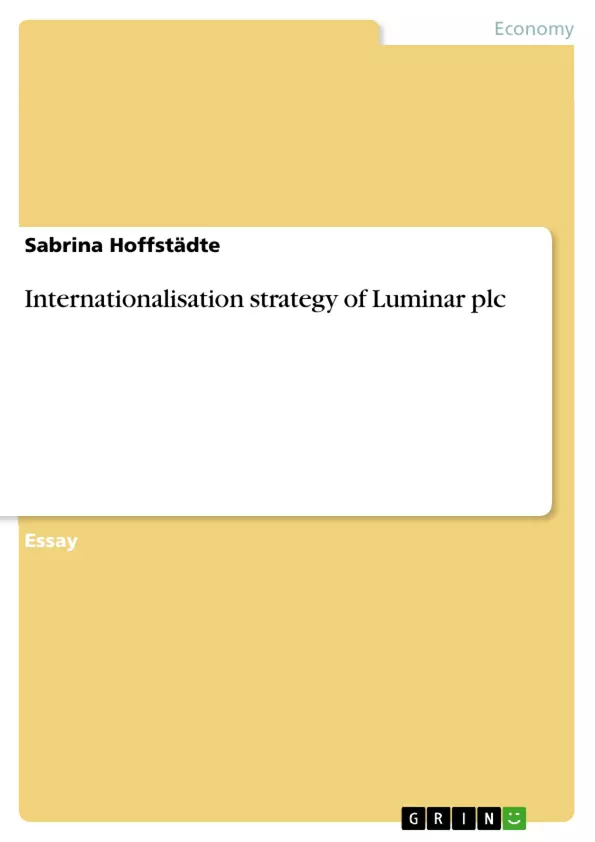Luminar plc is owner, developer and operator of themed bars, nightclubs and restaurants. Today the firm is UK’s largest operator of licensed late-night venues. For the fiscal year ending March 2006, the company announced a turnover of £338 million, a decrease of 10% against the previous year. Due to a general downturn, and over-capacity of the market sector, Luminar experiences a hard time to realize further growth in the home market. (Datamonitor 2005, Luminar Annual Report 2006). Consequently, the firm is looking for ways to expand its business by evaluating possibilities for growth such as exporting the successful concept to markets outside the UK One strategic option Luminar is evaluating regarding entry mode into foreign markets is cross-border M&A. The author will discuss this method with regard to reasons, success factors and failure rates, and possible difficulties. The author concludes that Luminar should be conscientious in implementing this method as it may have negative effects on shareholder wealth.
It is observed that many managers seek to maximize size of the firm rather than shareholder value through M&A (Walker 2000). Figure1 in the appendix exhibits some major motives for international M&A activities. Other objectives are economies of scale, risk spreading, market power increase, diversification, and the ability to move quickly at comparably low cost (Schuler et al. 2001, Walker 2000).
It should be one of the main objectives of a firm to increase the wealth of its shareholders (Bruner 2002). Shareholder wealth, or sooner the correlating term shareholder value, is here defined as “the present value of expected future cash flows discounted at a rate that appropriately reflects the relevant risk” (McCarthy 2004:11). In general, shareholders aim for growth in profits (MacDonald 2005). Besides other options, shareholder value is created when a firm’s management makes incremental investments which yield rates of return higher than the invested cost of capital (McCarthy 2004).
Managers then have to make a decision whether to grow internally by starting their own business which is very time- and resource-intensive, or by purchasing of or merging with a company in the same or related branches of business and thus saving time and strength (Picot 2002).
Inhaltsverzeichnis (Table of Contents)
- Section A, ii)
- Section B, c).
- Appendix
- References
Zielsetzung und Themenschwerpunkte (Objectives and Key Themes)
This report aims to analyze the viability of cross-border mergers and acquisitions (M&A) as an internationalization strategy for Luminar plc, a leading operator of themed bars, nightclubs, and restaurants in the UK. The report explores the reasons, success factors, and failure rates associated with cross-border M&A, considering the potential impact on shareholder wealth.
- The importance of shareholder value creation and maximizing returns on investment.
- The strategic objectives and motivations behind M&A activities, including economies of scale, risk spreading, market power increase, and diversification.
- The potential risks and challenges of M&A, including the high failure rate, cultural conflicts, and the difficulty of successful integration.
- The critical factors for success in M&A, emphasizing thorough due diligence, experienced management teams, clear communication, and a shared vision.
- The implications of M&A for Luminar's stock price and future financial performance, focusing on the need to avoid overpaying and prioritizing strategic objectives.
Zusammenfassung der Kapitel (Chapter Summaries)
The report begins by outlining the current state of Luminar plc, highlighting its position as the UK's largest operator of licensed late-night venues. It then delves into the challenges faced by Luminar in the home market and the rationale for considering international expansion through M&A. The report further examines the key motives for international M&A and discusses the importance of shareholder value creation as a primary objective.
The following sections explore the potential downsides of M&A, including the high failure rate and the negative impact on shareholder wealth. This is supported by empirical evidence and case studies, including the DaimlerChrysler merger and the failed Renault-Volvo merger. The report also analyzes the factors contributing to unsuccessful M&A transactions, such as overpaying, cultural conflicts, lack of resources, and poor integration processes. Conversely, the report discusses key success factors, such as thorough due diligence, strong leadership, realistic expectations, and effective communication.
The report concludes by drawing implications for Luminar's decision to pursue an M&A strategy, emphasizing the importance of careful due diligence, strategic objectives, and avoiding overpaying. It highlights that profitable growth is the key driver of shareholder value and that growth alone does not automatically generate value.
Schlüsselwörter (Keywords)
This report focuses on key concepts such as internationalization strategy, cross-border mergers and acquisitions (M&A), shareholder wealth, strategic objectives, success factors, failure rates, due diligence, integration processes, and cultural conflicts. The report also examines the impact of M&A on stock prices and financial performance.
- Citar trabajo
- Sabrina Hoffstädte (Autor), 2007, Internationalisation strategy of Luminar plc, Múnich, GRIN Verlag, https://www.grin.com/document/70619



